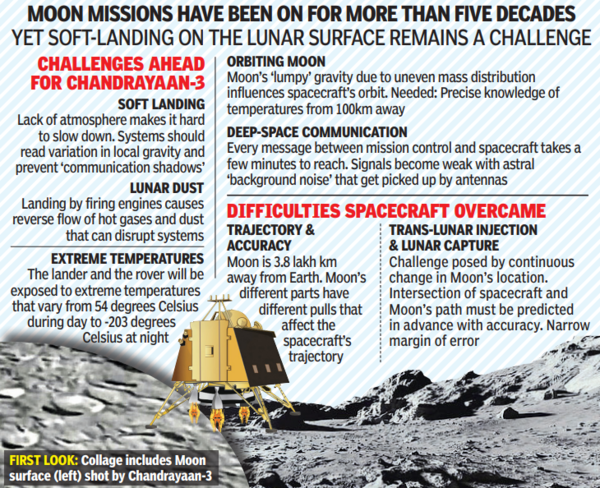[ad_1]
Four years after Chandrayaan-2 crash-landed on the lunar surface, India is at the cusp of making history by landing a probe in the polar region of the Moon. If all goes well, Vikram, the Chandrayaan 3 lander, will touchdown a little after 6pm on Wednesday and, a few hours later, the rover named Pragyan will roll out of its belly.
The US, Russia and China have landed probes on the Moon, three of them in the southern latitudes, but India will be the first, if successful, to land close to the lunar south pole. Learning from the previous failure, Vikram this time has sturdier legs that can withstand landing velocities up to 10.8kmph. Isro said Vikram has been having a smooth sail. “The mission is on schedule. Systems are undergoing regular checks. Smooth sailing is continuing. The mission operations complex (MOX) is buzzing with energy & excitement,” it said.

Isro released images captured by the “lander position detection camera” (LPDC) from an altitude of about 70km, taken on August 19, and those taken by lander imager camera-4 on August 20. “The LPDC images assist the lander module in determining its position (latitude and longitude) by matching them against an onboard Moon reference map,” Isro said.

03:38
Chandrayaan-3 Mission: Vikram lander separates successfully, now landing on Moon on August 23
Overall process of moon landing may take 30 minutes: Isro chief
On the eve of Vikram’s scheduled landing attempt near the Moon south pole on Wednesday, Isro said all systems were working as per plan. “The mission is on schedule. Systems are undergoing regular checks. Smooth sailing is continuing. The mission operations complex (MOX) is buzzing with energy & excitement,” the agency said.
Isro released images captured by the “lander position detection camera” (LPDC) from an altitude of about 70km, taken on August 19, and those taken by lander imager camera-4 on August 20. “The LPDC images assist the lander module in determining its position (latitude and longitude) by matching them against an onboard Moon reference map,” Isro said.
Isro chairman S Somanath told TOI that the overall process of landing may take around 30 minutes. “The exact timeline would depend on the systems and landing conditions. We have to decide whether to land at the first visible site or choose another safer spot based on hazard detection,” he said.
After landing, Vikram will extend a ramp for Pragyan to roll out and explore the surface and start studies. Isro has packed Vikram and Pragyan with instruments. The lander and the rover are designed to function for one lunar day (14 Earth days).
A senior Isro scientist said: “Our job ends only after Vikram and Pragyan complete the lunar day. Landing is the first step towards ensuring that.” Before getting into the landing mode, Isro had established a two-way communication between Vikram and Chandrayaan-2 orbiter, giving mission control more channels to reach the landing module.
Among the landing challenges would be lunar dust. Firing onboard engines close to the surface results in backward flow of hot gases and dust. The hard, fine lunar dust has negative charge which makes it stick to surfaces and thereby interfere with deployment mechanisms including that of the solar panel.
Watch National Emblem on Moon: Chandrayaan-3 Rover to leave India’s imprint on the lunar surface
[ad_2]
Source link



